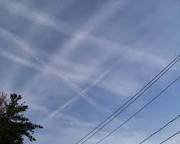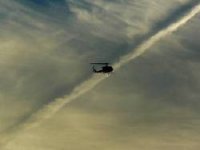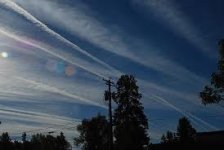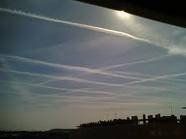By the way both of these were harvested the disease gets much much worse and defoliates the plant. No trees in this area which I believe helped save these plants. Normally I chose a spot with small trees for security. If you look closely at the grass around the plants you can also see leaf spot damage.
You are using an out of date browser. It may not display this or other websites correctly.
You should upgrade or use an alternative browser.
You should upgrade or use an alternative browser.
LC/Greencure: OD Disease Control Dangers!
- Thread starter moondawg
- Start date
Hey all I havn't read through all the posts in both threads so this all might have been said before. But I have been reading bith threads here and there and decided to go through my gardening books to see what they say. Most my books say the disease is common in fruit trees and thats all they really say. But I do have an Organic gardening book with I think the best advice.
Bacterial Leaf Spot ( Xanthomonas Pruni ) Plant resistant varieties. Fertalize to maintain vigoaous growth. Prune to improve circulation.
Mulch to prevent dirt and spores from being splashed up onto plants.
Remove infected Leaves
Biocarbonate sprays can be very helpful in preventing leaf spot diseases
Bicarbonate spray = A comercial Biocarbonate spray is GreenCure. You can make a homeade spray by dissolving 1 teaspoon of backing soda and 1 drop of liquid soap in 2 quarts of water mix well and spray on plants. A Higher concentration isn't better!!! They may burn your plants.
You guys where also talking about Copper on your plants so I include this also
Copper
Copper is a powerful, nonspecific fungicide that kills disease organisms. (sounds good so far). It damages beneficial soil and microorganisms and beneficial insects and is more toxic than sulfer to plants. Repeat applications of any copper product will stunt plants. Copper sulfate is classified as very toxic to humans. Organic gardeners often choose to avoid copper fungicides when possible because of there negative effects on nonpest species.
Bacterial Leaf Spot ( Xanthomonas Pruni ) Plant resistant varieties. Fertalize to maintain vigoaous growth. Prune to improve circulation.
Mulch to prevent dirt and spores from being splashed up onto plants.
Remove infected Leaves
Biocarbonate sprays can be very helpful in preventing leaf spot diseases
Bicarbonate spray = A comercial Biocarbonate spray is GreenCure. You can make a homeade spray by dissolving 1 teaspoon of backing soda and 1 drop of liquid soap in 2 quarts of water mix well and spray on plants. A Higher concentration isn't better!!! They may burn your plants.
You guys where also talking about Copper on your plants so I include this also
Copper
Copper is a powerful, nonspecific fungicide that kills disease organisms. (sounds good so far). It damages beneficial soil and microorganisms and beneficial insects and is more toxic than sulfer to plants. Repeat applications of any copper product will stunt plants. Copper sulfate is classified as very toxic to humans. Organic gardeners often choose to avoid copper fungicides when possible because of there negative effects on nonpest species.
S
stratmandu
Well, I had some sativas that were within 50 yards of dying WW with everything around them spotting up and they never got it, and its some kickass smoke. I pollinated that with an even stronger haze that also had no spots, and plan on growing those second-season acclimatized F1's, along with some skunk strains, in the same spots with NO copper. All OMRI or die. I have tons of great strains to try but am leery of wasting a crop of some hard-to-score beans outdoor just yet.
DS on my walkabouts I still see it everywhere on all the dead leaves. There's no spraying 100s of acres. I am going with resistant strains, period. I will try a few exotics I picked up over the winter on the bay, I can't resist it, but I'm going heavy with what worked last year. Oh yeah, grabbed some packs of Paradise reg sensi star just because of your report. (passed on the blue hash)
(passed on the blue hash)
DS on my walkabouts I still see it everywhere on all the dead leaves. There's no spraying 100s of acres. I am going with resistant strains, period. I will try a few exotics I picked up over the winter on the bay, I can't resist it, but I'm going heavy with what worked last year. Oh yeah, grabbed some packs of Paradise reg sensi star just because of your report.
 (passed on the blue hash)
(passed on the blue hash)You'll be happy you grew SS stratmandu, fungus or not! I cant hellp but wonder why Paradise has some disease resistant strains. Rox is resistant to everything.
hamstring, there are lots of gardeners that also swear by the use of compost tea and there's some reasonable evidence that it might work well on blight.: yes, i said compost tea. But im with you on the hydrogen peroxide. Im affraid of the copper, but....
Ive learned a lot about OMRI. Lcopper is listed by omri as organic approved. Ive discovered however, that listing with OMRI cost around $25, $50,000. ORMI has to review testing, perhaps do some of their own, etc and its expensive. It appears that big corporations get products like LC approved because they have the money, while a smaller company may not be able to afford OMRI listing for their products. Bottom line, OMRI listing is iffy at best and shouldnt be taken as gospel. Having said that, Lcopper is used on leaf lettuce and is considered safe. ????? Its confusing to me.
Ive done tons of reading and ive learned that our disease, or group of diseases are closely related to "late blight" on tomatoes. The fungus is the same family and treatments for it are the same. I belong to 3 different gardening forums and for the last couple of days ive been posting discussion threads about the disease. Many of the members of these forums are professional and master gardners operating large commercial nurseries and hundreds of acres of commercial organic gardening. Many are degreed in agriculture or botany. They are fairly unanimous in their understanding of the disease and their aproach to fighting the disease.. They emphasize prevention(Guyute54's list) and consider efforts to fight the disease after it has infected the plant as ineffective and only provide limited results. A member that grows 600 acres of potatoes commercially told me that if blight hits his patch, his harvest is reduced by over 50% regaurdless of what treatments he applies. He uses LC, but states that it only allows the plants to remain alive until harvest but his yeild is still devestated.
They claim that any approach aimed at "curing" the disease is futile. Only prevention can address the problem. Mulching around plants, avoiding over fertilization, spraying the soil and any nearby dead vegetation, rotation of crops and rotation of fungicides so that resistance isnt developed, ("best practices") and prevention treatments to the plants before the disease presents itself. They are unanimous in their belief that once the disease presents itself, no treatment or action can avoid serious damage to the crop.
hamstring, there are lots of gardeners that also swear by the use of compost tea and there's some reasonable evidence that it might work well on blight.: yes, i said compost tea. But im with you on the hydrogen peroxide. Im affraid of the copper, but....
Ive learned a lot about OMRI. Lcopper is listed by omri as organic approved. Ive discovered however, that listing with OMRI cost around $25, $50,000. ORMI has to review testing, perhaps do some of their own, etc and its expensive. It appears that big corporations get products like LC approved because they have the money, while a smaller company may not be able to afford OMRI listing for their products. Bottom line, OMRI listing is iffy at best and shouldnt be taken as gospel. Having said that, Lcopper is used on leaf lettuce and is considered safe. ????? Its confusing to me.
Ive done tons of reading and ive learned that our disease, or group of diseases are closely related to "late blight" on tomatoes. The fungus is the same family and treatments for it are the same. I belong to 3 different gardening forums and for the last couple of days ive been posting discussion threads about the disease. Many of the members of these forums are professional and master gardners operating large commercial nurseries and hundreds of acres of commercial organic gardening. Many are degreed in agriculture or botany. They are fairly unanimous in their understanding of the disease and their aproach to fighting the disease.. They emphasize prevention(Guyute54's list) and consider efforts to fight the disease after it has infected the plant as ineffective and only provide limited results. A member that grows 600 acres of potatoes commercially told me that if blight hits his patch, his harvest is reduced by over 50% regaurdless of what treatments he applies. He uses LC, but states that it only allows the plants to remain alive until harvest but his yeild is still devestated.
They claim that any approach aimed at "curing" the disease is futile. Only prevention can address the problem. Mulching around plants, avoiding over fertilization, spraying the soil and any nearby dead vegetation, rotation of crops and rotation of fungicides so that resistance isnt developed, ("best practices") and prevention treatments to the plants before the disease presents itself. They are unanimous in their belief that once the disease presents itself, no treatment or action can avoid serious damage to the crop.
harold
Member
http://www.sovereignindependent.com/?p=9344
For anyone doubting the existence of the phenomenon of ‘chemtrails’, please take a minute to read through this extensive list of patents from America on equipment and processes used in just such programs. The evidence is clear folks.
WE ARE BEING SPRAYING LIKE VERMIN!
One of the chemical culprits in high concentration in chemtrail spraying! and i feel the real problem to the new age decline in plant health.
Highly toxic concentrations of Manganese in soils can cause swelling of cell walls, withering of leaves, and brown spots on leaves.
http://aircrap.org/chemtrails-aerosol-toxicity-report/33809/
For anyone doubting the existence of the phenomenon of ‘chemtrails’, please take a minute to read through this extensive list of patents from America on equipment and processes used in just such programs. The evidence is clear folks.
WE ARE BEING SPRAYING LIKE VERMIN!
One of the chemical culprits in high concentration in chemtrail spraying! and i feel the real problem to the new age decline in plant health.
Highly toxic concentrations of Manganese in soils can cause swelling of cell walls, withering of leaves, and brown spots on leaves.
http://aircrap.org/chemtrails-aerosol-toxicity-report/33809/
Attachments
The real nut to crack here is long term effectiveness. All these guys who can grow in their yards can throw every organic product at their plants, manage water perfectly, apply nutes as needed, sit and stare at their plants just waiting for anything to go wrong. Guerrillas can't do this. All these organic practices work, but you have to be right there to make them work. Hydrogen peroxide, compost teas, exploding the beneficial microherd, yeah, I do that with my landscape and vegetable plants. I walk around in the morning with my cup of tea and look for issues. Come home after work, grab a cold one and do the same. It's pretty easy to stay on top of things. But marijuana planted outside in May has to stay healthy right up to the last minute in October. That is a long time to babysit, and guerrilla growers,(at least me) can't do that. I won't do that. I don't see a chemical solution. I have fought blight all my gardening life and I have never declared victory. In my mind the only answer is DISEASE RESISTANCE, unless you are willing to do autoflowers which finish long before outdoor problems arise.
darby crash
Member
Besides a fungicide you prolly should use a pesticide too. No telling how the disease travels. Could be carried by insects, so best add a good pesticide to your preventitive measures. Keep the carrier away keep the disease away.
Best of luck to you all.
Best of luck to you all.
i wonder if the government are fucking with us?... im being serious, i know they have sprayed poisons to try and eradicate the coca plant.
If the government wanted people to stop growing weed, all they would have to do is toss a handful of active, male hemp pollen out the chopper every couple minutes from 10K feet up. The winds would ensure that every plant in their path would be garbage at the end of the season.
harold
Member
that wouldnt eradicate it, maybe lower the potency...
i find it interesting that monsanto have developed aluminium resistant papaya and pineapples, as most of these crops are being ruined by excessive chemtrail spraying and wont grow anymore, strange coincidence? i think monsanto knows a few things we dont.
I know alot of you doubt the existence (or more like dont want to believe it) of chemtrails, many people have taken samples of the air and it has tested positive, sometimes 60,000 parts per billion! of aluminium and other toxic heavy metals. Soil samples, pond samples, mountain snow samples are all toxic with this crap, its killing trees, wild life (think decline in bees) the soil micro herd, soil ph and now its effecting our beloved plant too.
look at these images and tell me these are contrails?
i find it interesting that monsanto have developed aluminium resistant papaya and pineapples, as most of these crops are being ruined by excessive chemtrail spraying and wont grow anymore, strange coincidence? i think monsanto knows a few things we dont.
I know alot of you doubt the existence (or more like dont want to believe it) of chemtrails, many people have taken samples of the air and it has tested positive, sometimes 60,000 parts per billion! of aluminium and other toxic heavy metals. Soil samples, pond samples, mountain snow samples are all toxic with this crap, its killing trees, wild life (think decline in bees) the soil micro herd, soil ph and now its effecting our beloved plant too.
look at these images and tell me these are contrails?
Attachments
-
chem.bmp148.6 KB · Views: 44
-
 chemtrails4.jpg35.7 KB · Views: 13
chemtrails4.jpg35.7 KB · Views: 13 -
chemy.bmp148 KB · Views: 24
-
 imagesCA4BXR6O.jpg3 KB · Views: 25
imagesCA4BXR6O.jpg3 KB · Views: 25 -
 imagesCA4S2P4U.jpg8.4 KB · Views: 16
imagesCA4S2P4U.jpg8.4 KB · Views: 16 -
 imagesCA8CLRUG.jpg3.7 KB · Views: 18
imagesCA8CLRUG.jpg3.7 KB · Views: 18 -
 imagesCAFSH7GL.jpg3.9 KB · Views: 16
imagesCAFSH7GL.jpg3.9 KB · Views: 16 -
 imagesCAEFVJW2.jpg6.6 KB · Views: 16
imagesCAEFVJW2.jpg6.6 KB · Views: 16 -
 imagesCAB0918U.jpg3.2 KB · Views: 18
imagesCAB0918U.jpg3.2 KB · Views: 18 -
 imagesCAA9UKTF.jpg4.9 KB · Views: 13
imagesCAA9UKTF.jpg4.9 KB · Views: 13
harold
Member
Theres more. Personally when i see this it scares the shit out of me, because it wasnt always like this.
Attachments
I have fought blight all my gardening life and I have never declared victory. In my mind the only answer is DISEASE RESISTANCE, unless you are willing to do autoflowers which finish long before outdoor problems arise.The real nut to crack here is long term effectiveness. All these guys who can grow in their yards can throw every organic product at their plants, manage water perfectly, apply nutes as needed, sit and stare at their plants just waiting for anything to go wrong. Guerrillas can't do this. All these organic practices work, but you have to be right there to make them work. Hydrogen peroxide, compost teas, exploding the beneficial microherd, yeah, I do that with my landscape and vegetable plants. I walk around in the morning with my cup of tea and look for issues. Come home after work, grab a cold one and do the same. It's pretty easy to stay on top of things. But marijuana planted outside in May has to stay healthy right up to the last minute in October. That is a long time to babysit, and guerrilla growers,(at least me) can't do that. I won't do that. I don't see a chemical solution.
well put my friend I like the cut of your jib.

I certainly agree with you ronbo, but i disagree slightly with your conclusion that the only successful approach is strain resistance. Because i have grown a number of strains during the past 2 years, i know that strains react differently to the disease and they respond differnently to the treatments.
For example: Biddy Early was very succeptable to the disease and while Lcopper did seem to set the disease back, it came roaring back within days. Repeated applications tended to stall the disease but didnt do anything except to keep the plants alive. The yeild was devastated.
GHS White widow was also quite succeptable, but 1 app of Lcopper whipped it and a second app killed it all together. The plants returned to normal growth and color. They did however, become reinfected as soon as the LC deteriorated. Within 2 weeks, more spotted yellow leaves would appear and i would have to reapply --again the LC killled it.
Sensi star. There is no question that had i applied any remotely effective treatment in advance, there would have been no display of the disease whatsoever and when treatments are applied, the disease and its effectes disappear and dont really return. Even if the disease is left untreated in sensi star, the plants never completely defoliate and the growth and yield is impacted far less.
Choosing Biddy Early leaves the grower without hope. Choosing WW or Sensi star does provide the grower with the hope of a harvest.
Its my view that our defense must be 3 fold.
1. Prevention. Mulch/ spray ground and surrounding veg/ dont over fertilize
2. Strains that respond to treatments or that resist the disease must be chosen
3. Preventative treatments of an effective fungicide. Perhaps LC until flowering sets and then HydrogenP or Organicide.
Last year, had i known about LC 2 weeks earlier, i coulld have dramatically changed my eventual outcome. The delay that occurred while i was searching for a treatment was the time required for the disease to take hold and impact the grow. I believe that If a grower chooses a resistant strain, then engages in "best practices" of mulching, ground spraying, etc, and then applies preventative initial treatments followed by another weekly treatement, the disease would be killed and the need for daily trips would be reduced.
thats my thinkin anyway.....
For example: Biddy Early was very succeptable to the disease and while Lcopper did seem to set the disease back, it came roaring back within days. Repeated applications tended to stall the disease but didnt do anything except to keep the plants alive. The yeild was devastated.
GHS White widow was also quite succeptable, but 1 app of Lcopper whipped it and a second app killed it all together. The plants returned to normal growth and color. They did however, become reinfected as soon as the LC deteriorated. Within 2 weeks, more spotted yellow leaves would appear and i would have to reapply --again the LC killled it.
Sensi star. There is no question that had i applied any remotely effective treatment in advance, there would have been no display of the disease whatsoever and when treatments are applied, the disease and its effectes disappear and dont really return. Even if the disease is left untreated in sensi star, the plants never completely defoliate and the growth and yield is impacted far less.
Choosing Biddy Early leaves the grower without hope. Choosing WW or Sensi star does provide the grower with the hope of a harvest.
Its my view that our defense must be 3 fold.
1. Prevention. Mulch/ spray ground and surrounding veg/ dont over fertilize
2. Strains that respond to treatments or that resist the disease must be chosen
3. Preventative treatments of an effective fungicide. Perhaps LC until flowering sets and then HydrogenP or Organicide.
Last year, had i known about LC 2 weeks earlier, i coulld have dramatically changed my eventual outcome. The delay that occurred while i was searching for a treatment was the time required for the disease to take hold and impact the grow. I believe that If a grower chooses a resistant strain, then engages in "best practices" of mulching, ground spraying, etc, and then applies preventative initial treatments followed by another weekly treatement, the disease would be killed and the need for daily trips would be reduced.
thats my thinkin anyway.....
I'm thinking the heavy indica strains would be better choices then if your having this problem? Seems as Idie's have much tougher folliage in my experiance's.
My approach this season is to try and keep my plants much more healthier from the get go with compost teas for drenching and for foliar sprays. I have been doing lots of reserch on em and have found out there is no need for pumps or anything other than a bucket and compost and something to stir it. They call it steeping (sp?) ..
My approach this season is to try and keep my plants much more healthier from the get go with compost teas for drenching and for foliar sprays. I have been doing lots of reserch on em and have found out there is no need for pumps or anything other than a bucket and compost and something to stir it. They call it steeping (sp?) ..
Ajunta Pall
Member
Mold was a problem I had back at the harvest of 09, so last year I took a few steps I'm sure that could be applied to leaf spot. I hated to do it but I dug up and disposed of the native soil becuase I wasn't gonna chance their being mold spores in it. Same for bacteria. Hamstring said it over winters, if thats the case it must produce spores too.
Before planting and after a couple of rain showers mid to late May, I went out and used LC on the ground and on the native plants closest to my grow. A couple of weeks went by and I resprayed and planted my girls. Over the course of summer I would retreat my plants every 2-3 weeks, but that was easy last year, because it was so damn hot I made plenty of trips hauling water. The last 3 weeks of flowering I left off.
It did the trick and because mold was not an issue at the end of the season as it was the previous two past. I know mold and leaf spot aren't the same but both can flourish when conditions are right. Its up to you to make sure conditions are never right. With an ounce of prevention you can keep both of these little devils under control.
Before planting and after a couple of rain showers mid to late May, I went out and used LC on the ground and on the native plants closest to my grow. A couple of weeks went by and I resprayed and planted my girls. Over the course of summer I would retreat my plants every 2-3 weeks, but that was easy last year, because it was so damn hot I made plenty of trips hauling water. The last 3 weeks of flowering I left off.
It did the trick and because mold was not an issue at the end of the season as it was the previous two past. I know mold and leaf spot aren't the same but both can flourish when conditions are right. Its up to you to make sure conditions are never right. With an ounce of prevention you can keep both of these little devils under control.
Hey ajunta pall, can you/did you taste the LC in the cured bud? Do you feel that copper was present in any way on your cured buds? Im worried about being poisoned.
Ajunta Pall
Member
DS Toker I've been gardening for the longest, and with my veggies and stuff I wash them before canning. Same with bud, I cut it and take back to my drying area where I wash it throughly, well spray it with a garden hose. Also the last few applictions of fungicide/pesticide are only half strength. When my plants are in the home stretch and are looking healthy I try to not put anything on them unless I have to.
harold
Member
https://www.icmag.com/ic/showthread.php?t=161425
how to kill pm forever.... looks like this dude may have an answer for you, i wonder if it works on leafspot fungus too?
how to kill pm forever.... looks like this dude may have an answer for you, i wonder if it works on leafspot fungus too?
Eagle 20 is a systemic fungicide Harold. That means its nature isnt to coat the leaves but to actually enter the plants tissue where it is replicated. Its not ON the plant, it IN it. Thats too scary for me. Lcopper and several other products kill Pm without using a systemic. Those guys are going to kill themselves in my view!
J
johndoe123
Some solid information on Leaf Spot Treatment in this thread that deserves a bump!
Last edited:










